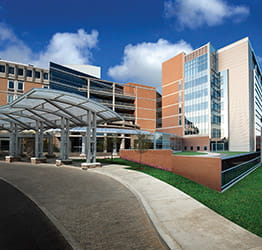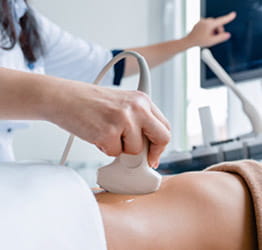What Is Breast Ultrasound?
After your mammogram, your doctor might refer you for a breast ultrasound to get a better image of your breast tissue. Breast ultrasound is a painless, noninvasive test that uses high-frequency sound waves to produce real-time pictures of your breast tissue.
Ultrasound machines consist of a:
- Computer.
- Video display screen.
- Small, handheld device that scans the body called a transducer.
During the exam, the transducer sends sound waves into your body. These waves bounce off the organs and structures inside your body, creating echoes that the transducer picks up. The ultrasound machine then converts these echoes into an image.
Conditions we diagnose with breast ultrasound
- Atypical ductal hyperplasia.
- Atypical lobular hyperplasia.
- Breast cancer.
- Breast cysts.
- Fibroadenomas.
- Fibroepithelial lesion.
- Flat epithelial atypia.
- Intraductal papilloma.
- Lobular carcinoma-in-situ.
- Microcalcifications.
- Mucocele-like lesion.
- Radial scar.
Why Would I Need Breast Ultrasound?
Your doctor may refer you for a breast ultrasound if:
- Additional screening is needed because you have dense breast tissue on your mammogram and you are not eligible to have a screening breast MRI.
- Your mammogram shows an abnormal area of tissue.
- You have nipple discharge, especially bloody discharge.
- You or your doctor found a lump or other change while examining your breasts.
Ultrasound can find some cancers not seen on a mammogram, but it also shows many false alarms that are not cancer and that may require additional testing.
Your radiologist may recommend a breast ultrasound to:
- Further evaluate areas of possible concern that were found on a mammogram, MRI, or other breast imaging test.
- Image the lymph nodes under your arm, if you have breast cancer or are suspected to have breast cancer.
- Plan a biopsy or localization procedure before surgery.
Who’s a candidate for breast ultrasound?
You may be a candidate for a breast ultrasound if your doctor needs a clearer view of your breast tissue because you have dense breasts, symptoms, or receive an abnormal result on a mammogram.
Breast ultrasound is the first test used to assess breast symptoms for patients under the age of 30 years. In women age 30 and over, a mammogram is typically performed first if the patient is not pregnant.
Will I still need a screening mammogram if I have a breast ultrasound?
A breast ultrasound does not replace a mammogram for routine screening. It’s often used in addition to mammography to get a more detailed view of your breast tissue — especially if you have dense breasts, symptoms, or your mammogram shows a mass or abnormality.
Ultrasound is typically the first test done to evaluate symptoms in women under age 30. Over age 30, a mammogram is usually performed first (if you are not pregnant).
Can I skip my mammogram if I have a normal breast ultrasound?
No. A normal ultrasound doesn't mean you can skip mammograms. Breast ultrasound is an important tool, but it is just one piece of a multimodal approach to breast care that also includes mammography, MRI (if needed), and clinical exams.
Alternatives to breast ultrasound
- Breast MRI.
- Contrast-enhanced mammography.
- Mammography.
What Are the Risks and Complications of Breast Ultrasound?
Breast ultrasound does not use radiation and there are no known side effects related to ultrasound imaging.
What Should I Expect From Breast Ultrasound?
Before: How to prepare for breast ultrasound
There are no restrictions and nothing you need to do to prepare for a breast ultrasound.
If you have had a mammogram performed at another facility, you must have your images sent to your UPMC imaging provider. You can also get a copy and bring them with you to your appointment. Your sonogram cannot be performed without these images for reference, and your appointment will be rescheduled if you do not bring them.
If your previous mammogram or other breast imaging was performed at a UPMC facility, your provider should be able to access your images.
How long does breast ultrasound take?
Focused breast ultrasound to get a more detailed view of a specific area typically takes only a few minutes. A screening breast ultrasound typically takes about 30 minutes.
During your breast ultrasound
A breast ultrasound is a painless, noninvasive exam, so you will not need any type of anesthesia. You will be asked to lie on your back or side with your arm raised on an exam table near the ultrasound machine.
During the test, your ultrasound technologist will:
- Apply a clear gel on the skin of your breast. A small handheld device called a transducer is used to scan your breast and/or underarm area at different angles.
- Record images and measurements for your radiologist to review.
Although the exam is not painful, the pressure from the transducer might feel firm in some areas.
Your technologist cannot give you the results of your ultrasound examination until your radiologist reviews your images. Your radiologist may also want to scan your breast or underarm.
Recovery after breast ultrasound
You can resume your normal activities immediately after your breast ultrasound.
How Will I Receive My Ultrasound Test Results?
You may be asked to wait while your images are reviewed by a board-certified breast radiologist. Your radiologist will review your ultrasound images together with your prior breast imaging and may rescan your breast. This is not unusual, so you should not be alarmed if it happens.
If you are having a diagnostic ultrasound due to symptoms or an abnormality, you will receive results and recommendations at the time of your appointment. If you are having a screening ultrasound, results will be sent to your healthcare provider and you will receive a letter.
You can also access your results through your UPMC patient portal. If you have any questions about your results, you can contact your doctor’s office via the portal or by phone.
When to call your doctor about complications
You should not experience any complications after your ultrasound.
Why Choose UPMC for Breast Ultrasound?
When you choose UPMC for breast ultrasound, you will receive:
- Access to advanced imaging technology — Our experts use the latest 3D mammography technology to diagnose breast abnormalities quickly and accurately.
- Convenient imaging services — Imaging appointments are available at multiple locations with hours that fit your schedule.
- Comprehensive care — We offer a full range of breast imaging tests to screen for and diagnose all types of breast disorders.
By UPMC Editorial Staff. Last reviewed on 2025-08-28.
















